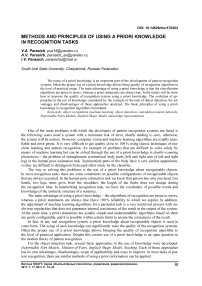Methods and principles of using a priori knowledge in recognition tasks
Автор: Parasich V.A., Parasich A.V., Parasich I.V.
Рубрика: Информатика и вычислительная техника
Статья в выпуске: 3 т.17, 2017 года.
Бесплатный доступ
The using of a priori knowledge is an important part of the development of pattern recognition systems. Often the proper use of a priori knowledge allows bring quality of recognition algorithm to the level of practical usage. The main advantage of using a priori knowledge is that the classification algorithms are prone to errors, whereas a priori statements are always true. In the article will be show how to improve the quality of recognition system using a priori knowledge. The evolution of approaches to the use of knowledge considered by the example of the task of object detection, the advantages and disadvantages of these approaches analyzed. The basic principles of using a priori knowledge in recognition algorithms formulated.
Object recognition, machine learning, object detection, convolution neural networks, deformable parts models, implicit shape model, knowledge representation
Короткий адрес: https://sciup.org/147155201
IDR: 147155201 | УДК: 004.855.5 | DOI: 10.14529/ctcr170302
Список литературы Methods and principles of using a priori knowledge in recognition tasks
- Felzenszwalb P.F., Girshick R.B., McAllester D., Ramanan D. Object Detection with Discriminatively Trained Part Based Models. IEEE Transactions on Pattern Analysis and Machine Intelligence, 2010, vol. 32, no. 9, pp. 1627-1645 DOI: 10.1109/TPAMI.2009.167
- Canavet O., Fleuret F. Efficient Sample Mining for Object Detection. Proceedings of the Asian Conference on Machine Learning (ACML), 2014, pp. 48-63.
- Leibe B., Leonardis A., Schiele B. An Implicit Shape Model for Combined Object Categorization and Segmentation. Springer Berlin Heidelberg, 2006, pp. 508-524 DOI: 10.1007/11957959_26
- Comaniciu D., Meer P. Mean Shift: A Robust Approach Toward Feature Space Analysis. IEEE Transactions on Pattern Analysis and Machine Intelligence, 2002, vol. 24. no. 5, pp. 603-619 DOI: 10.1109/34.1000236
- State Farm Distracted Driver Detection. Available at: https://www.kaggle.com/c/state-farm-distracted-driver-detection (accessed March 2017).
- Zhang S., Bauckhage C., Cremers A.B. Informed Haar-Like Features Improve Pedestrian Detection. The IEEE Conference on Computer Vision and Pattern Recognition (CVPR), 2014, pp. 947-954 DOI: 10.1109/cvpr.2014.126
- Wei S.E., Ramakrishna V., Kanade T., Sheikh Y. Convolutional Pose Machines. Proceedings of the IEEE Conference on Computer Vision and Pattern Recognition, 2016, pp. 4724-4732 DOI: 10.1109/cvpr.2016.511


